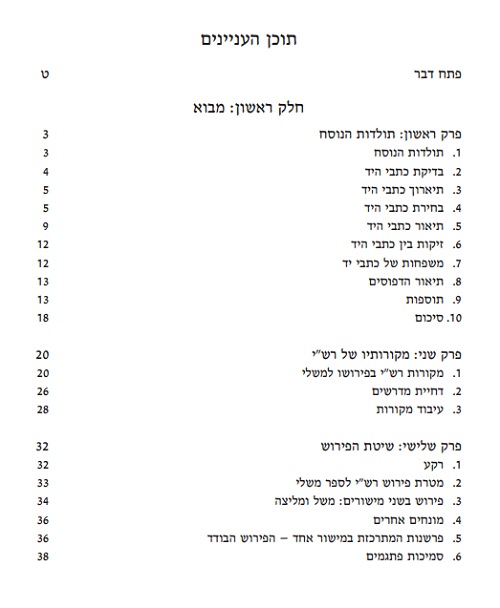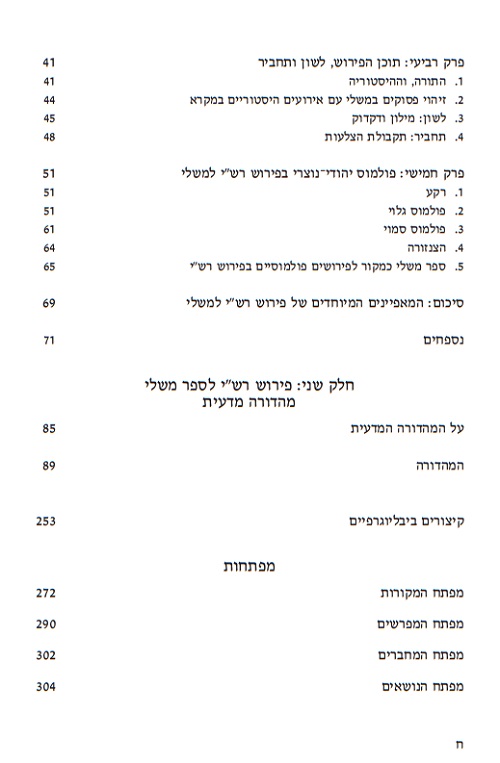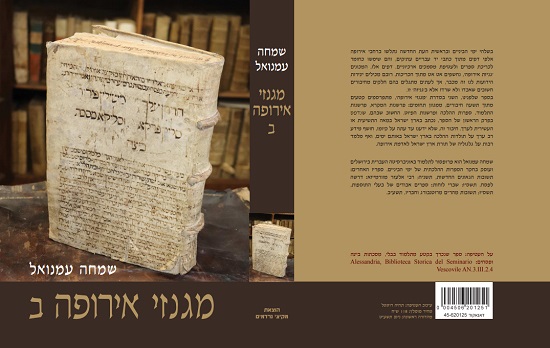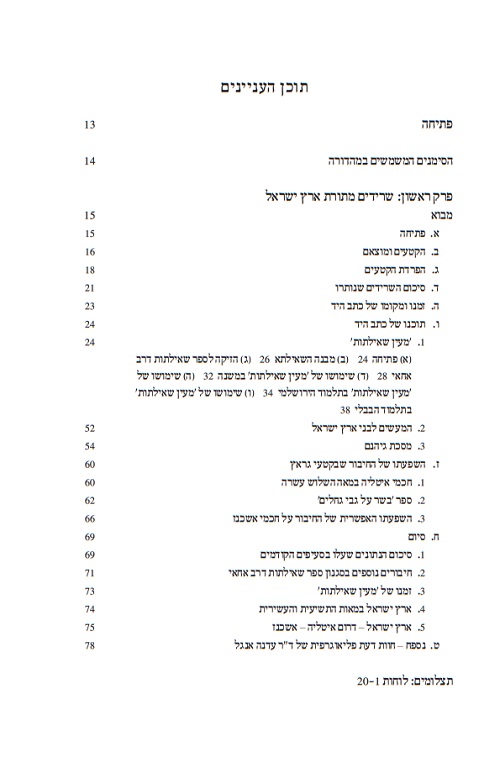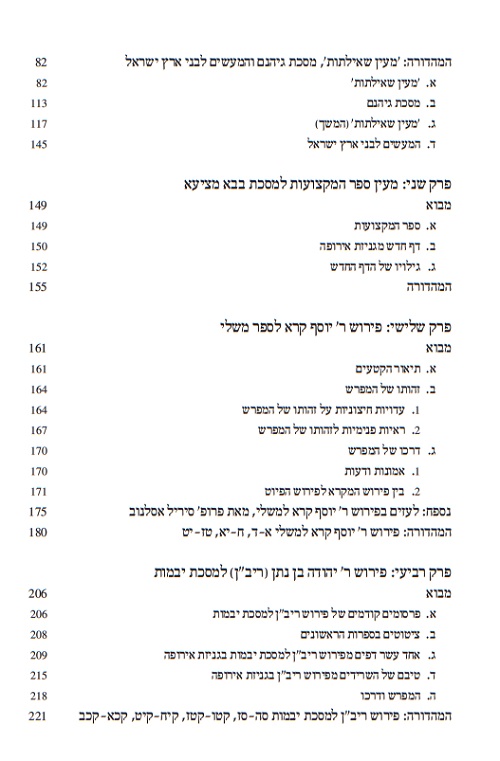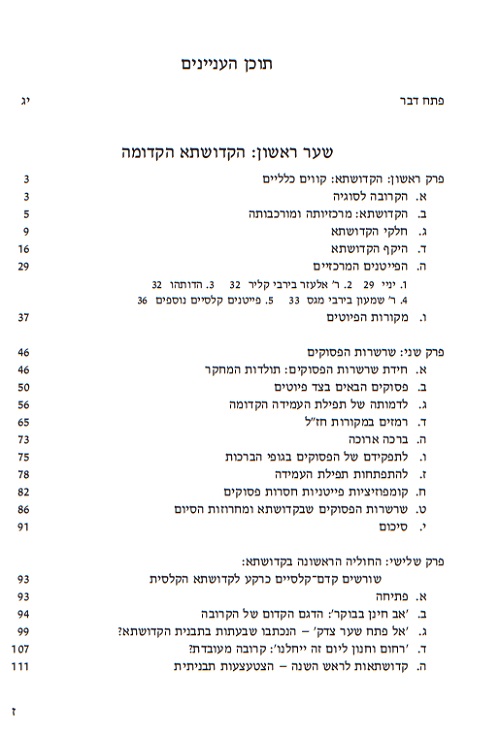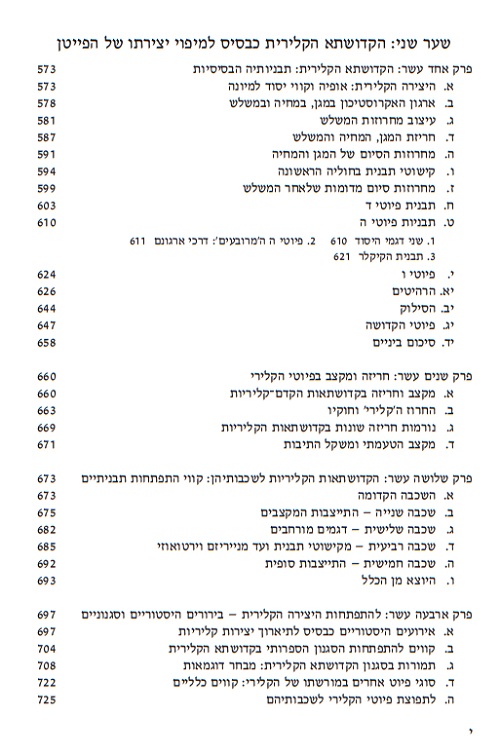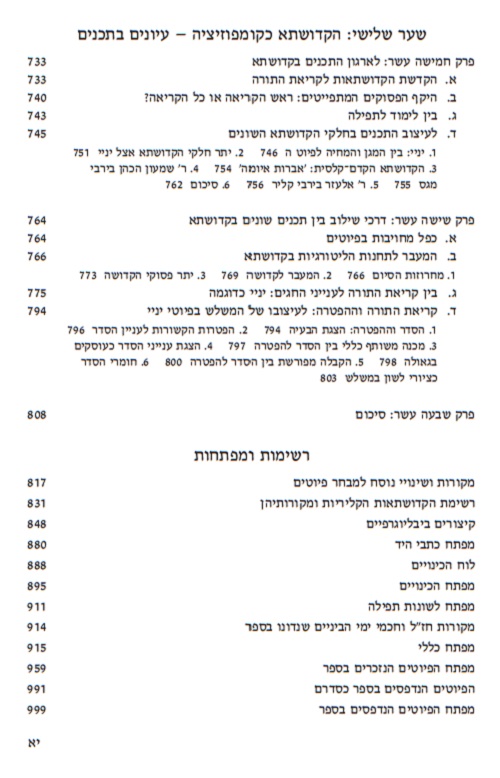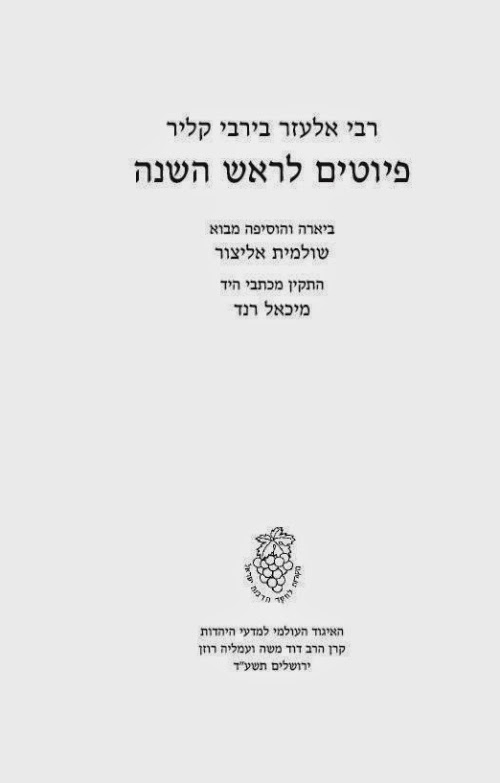ANCIENT JEWISH POETRY & THE AMAZING WORLD OF PIYUT: Professor Shulamit Elizur explores the Cairo Genizah and other obscure places for hidden gems
BY BATSHEVA SASSOON
Just as the mountains surround Jerusalem, so G-d surrounds his people, from now to all eternity —Tehillim 125:2
This piece originally appeared in14 TISHREI 5778 // OCTOBER 4, 2017 // AMI MAGAZINE #337
Thanks to Ami for permission to publish this here.This version is updated with a few corrections and additions
Inside the Old City of Jerusalem one cannot see the mountains that surround it, only its many confining walls. Yet even for someone who has a phobia of confined places, as I do, this part of the Holy City is liberating. Many years ago, the great Jewish poet Rabbi Yehudah Halevi wrote longingly about Jerusalem, “I wish I could fly to you on the wings of an eagle, and mingle my tears with your dust.” Today, one can readily fly to Jerusalem, but to have a chance to explore its poetic and emotional underpinnings is a rare treat.
Professor Shulamit Elizur, whom I am visiting this morning in her book lined apartment, is not only one of the foremost experts in the world on piyut but she is also a talmidah chachamah and scholar, whose fear of sin precedes her wisdom.
“I was around 16 years old when I realized that if you want to learn something, it isn’t wise to try to absorb too much at one time,” she shares with me without a hint of pretension. “I decided to study the Mishneh Torah of the Rambam, so I learned one perek a day until I got to the end. I did the same thing with Nach, learning two perakim a day, and I’ve gone through the entire Shishah Sidrei Mishnah numerous times. The same applies to piyutim: If you divide them up and study them over time, you will eventually succeed in understanding all of them.”
She then asks me not to mention some of her other scholarly undertakings so that she doesn’t come across as if she were bragging. And she’s not; she is simply a brilliant scholar who loves to learn every spare minute, and the world has been tremendously enriched by that. As the head of the Fleischer Institute for the Study of Hebrew Poetry, a member of the Academy of the Hebrew Language and a member of the editorial board of the Mekitze Nirdamim publishing house, she has her hands full. But she still finds time to write books and study, as well as to talk to me this morning about her ongoing research. Indeed, her energy is laudable as she keeps on getting up to fetch one book after the other to prove a point.
GENIZAH
Anyone who is familiar with contemporary Israeli culture knows that there has been a revival of the singing of piyut. Jewish liturgical poems that were composed to be recited during tefillah are now being performed by Israel’s top singers in clubs and at concerts. But Shulamit Elizur insists that what she does has nothing to do with this trend.
“The modern performers are mainly interested in the piyutim that have tunes, and those that are printed in our siddurim. But I’m involved in doing research into the piyutim that were lost and haven’t been said in many years. My field is kitvei yad, primarily those that were found in the Cairo Genizah.”
I ask her if after all these years it’s still possible to find new things.
“We have an organization that takes all the fragments and deciphers them. For example, I found a fragment of a page and then much later I found another piece of the same page. It turns out that the page is part of a sefer written by Rabbeinu Saadyah Gaon against the Kara’im. We don’t have the entire book, but the two pieces I was able to put together are from a previously unknown part of that sefer, which was very exciting for me.”
“So it’s all about putting pieces together,” I state.
“Yes, although we do sometimes find complete pages as well. For example, I discovered a piyut for Tefillat Geshem on Shemini Atzeret that isn’t found in our siddurim and predates the great paytan Rabbi Elazar Hakalir, who lived in Eretz Yisrael close to the Muslim conquest. It is very unique and I published it in one of my articles.
“When we go through the Genizah, we examine each piece individually to try to understand what it is. We have a catalogue with over 160,000 entries. That doesn’t mean that there are that many piyutim, because if we find the same piyut five times it gets five separate entries. But there are tens of thousands of them, most of which are unknown, and we are constantly finding more. The next step is to upload them onto a website to make them accessible to the public, but right now we don’t have the funds to complete the project.
“We still have a few years of research left, because even though we’ve gone through every fragment found in the Genizah that was known to be a piyut, there are still many more that weren’t known to be parts of piyutim. In Cambridge, the Genizah was organized according to category: There are contracts, letters, parts of Tanach, Talmud and piyutim. My teacher, Ezra Fleischer, began the work of examining all the other categories for fragments that were previously unrecognized as piyutim, and the work is not yet finished. For example, when a contract was no longer needed, the other side of it could then be used to write piyutim, but it was still categorized as a contract. So we still need to find all of those fragments of lost piyutim and piece them together.”
“How many fragments are in the Genizah?”
“Tens of thousands, and sometimes there can be as many as 50 piyutim on a single one. This is a very large undertaking. Ezra Fleischer worked on it for 40 years, and before he passed away he asked me to continue his work.”
“So you’re his successor.”
“For this project, but I don’t claim to come close to his stature. He was unbelievably knowledgeable in piyut, nusach hatefillah, secular poetry and languages; he spoke more than ten.”
“Was he born in Eretz Yisrael?”
“No. That’s another story, which is really deserving of its own article. He was born and raised in Romania. His father was Yehuda Leib Fleischer, who did research on Rav Avraham ibn Ezra, which is why he named his son Avraham Ezra.
“As a bachur, Ezra was an activist for immigration to Eretz Yisrael, so he was arrested and put in jail under extremely dangerous conditions. He was kept in solitary confinement for a number of years, so during that time he composed a number of Hebrew songs and poems in his head. When he was finally freed, he wrote three books of songs and poems from memory.
“He also wrote a book against the Communists, which he was able to put into the hands of the Israeli ambassador, who sent it to Israel and had it printed under a pen name. It received such wide acclaim that he received the Israel Prize for it anonymously while he was still in Romania. But he couldn’t reveal to anyone that he was the author, because he knew that the Romanians would kill him if word got out.
“A year later he was allowed to go to Israel, where he became friends with my parents. I was five years old when I first met him. He told me that he had studied law in Romania because that was the only exam that wasn’t held on Shabbat. He actually hated law, but he had to study something in university so he chose that. Still, even after he graduated he couldn’t get a job in a prestigious law office, which would have necessitated working on Saturdays, so he became the official secretary of the kehillah under Rav Rosen. He really had unbelievable mesirat nefesh to keep Shabbat.”
ACADEMIA
“How did you become interested in the study of piyut?”
“When I went to university I wanted to study the Hebrew language. But because I was required to add another subject I decided to add Hebrew literature, which my mother taught. Then Professor Fleischer invited me to join his project and I loved it. I took several courses with him and became more and more interested. I finished my bachelor’s degree after only two years and had to decide what to do next.
“In the meantime I had gotten married, and I wanted to make sure that whichever professor I learned under would help me advance in my studies. I also had a choice between studying for a master’s and a more difficult program that would allow you to start working towards your doctorate after a year of study. By then I was expecting, and I realized that the harder program would actually be easier for me because it allowed for much more study to be done at home. The problem was that the language department didn’t want to work with me within the parameters of this program. Since I loved the piyutim, I decided to try to do my doctorate with Ezra Fleischer and he agreed. After the initial year of post-graduate study it took me another three and a half years to receive my doctorate. So the whole thing from undergraduate to PhD took six and a half years, which was also when I gave birth to my third child.”
“Did you find that you had a harder time as a woman in a man’s field?”
“There were never any problems because of that.”
“Are you the highest-ranking professor of piyut in Hebrew University?”
“Yes. There are professors emeritus, but I’m the only one left who is still teaching. Aaron Mirsky, who was related to me, and Ezra Fleischer have both passed away. Then there’s Yosef Yahalom, but he is now retired.”
“Aaron Mirsky internalized the language of the paytanim, but people don’t write like that anymore.”
“That’s true, and sometimes it wasn’t easy to understand him. I remember that my mother once won a prize and Aaron Mirsky was one of the judges who gave a speech. He used the word ‘shigush,’ and throughout the entire evening my aunt kept asking what it meant. I told her that it was an Aramaic word from the piyutim. Incidentally, having a knowledge of targum is also very helpful when trying to understand the piyutim. I make sure to learn shnayim mikra v’echad targum every week. My father taught me Targum Onkelos when I was a young girl, and I taught it to my children as well.”
“Are most of your doctoral students at the university secular?”
“No. Most of them are religious.”
“Do your secular students look at all of this as simply another subject, or does it bring them closer to Yiddishkeit?”
“I really don’t know. Sometimes it does bring them closer. I’ve had students who told me that they weren’t familiar with any Tanach, so I told them to study two perakim a day to catch up. But only one person actually took my advice. I remember that it really bothered me at the time that she was the only one, because she wasn’t Jewish, but in the end she became a giyoret kahalachah and is a shomeret mitzvot.”
“Do you face any difficulties as a woman in this field in the world at large?”
“It’s a bit more complicated. I never go anywhere I’m not wanted.
TORAH KNOWLEDGE
“You must really have a lot of Torah knowledge for all of this,” I tell her.
“I need to learn all the time, so I do.”
“There certainly aren’t many women in the world who know as much Torah as you do,” I insist.
“Baruch Hashem, there are many women who are very knowledgeable today, although they might not be familiar with piyutim. At the last Siyum HaShas, the organizers realized that a lot of people were bringing their wives along, so they decided to have a separate women’s program and asked me to speak. I talked about a mesorah that emerges from the piyutim that Hillel and Shammai were actually brothers, and I explained what it really means. The paytan says that just as the Torah was originally given to two brothers, Moshe and Aharon, so too was it later given to Hillel and Shammai, who were also brothers. Then I showed them how Hillel is a continuation of Aharon and Shammai is a continuation of Moshe, and I brought many mekorot showing how each one had his own direction and how the two of them coming together b’achvah is the epitome of the entire Torah.”
“Where did you find all of those sources? In midrashim?”
“Some of them are from the Midrash, but there are a lot in chasidut as well.”
“In order to understand piyutim a person would have to study them for many hours, but we usually say them too quickly to really understand them.”
“That’s true. That’s why they should be learned properly before Yom Tov. But you don’t have to learn everything in a single year. You can do it gradually. I apply the same principle to the kinot of Tishah B’Av; each year, two should be studied properly. While we’re on the subject, I’d like to share something very interesting. The first kinah we say in the morning is alphabetical in order, but it only starts from the letter samech. What happened to the previous letters? Well, if you look in the machzorim of Nusach Italia you’ll find that they recite a krovetz for each brachah of Shmoneh Esrei. The paragraphs are arranged alphabetically from alef through nun, but they end at Bonei Yerushalayim. That’s because the original place to say kinot was in the middle of the brachah of Bonei Yerushalayim during Shmoneh Esrei! They didn’t say as many kinot as we do, though; they’d recite a few piyutim of kinot and then a few piyutim of nechamot. Similarly, the original minhag in Ashkenaz for Selichot on a taanit was to say it during the brachah of Slach Lanu.
“Studying piyutim reveals minhagim that have been forgotten. For example, on Rosh Hashanah they would blow the shofar in the Beit HaVaad (where the Sanhedrin of Eretz Yisrael sat) even when it occurred on Shabbat. But how was it actually done? There’s a piyut, published by Ezra Fleischer in Tarbiz 54 (reprinted in a volume of his collected writings, Statutory Jewish Prayers) that describes how they would bring the shofar before Shabbat and tie it securely to an amud so that it couldn’t move at all. When it came time to blow the shofar, the baal tekiah would blow the shofar with his mouth without touching it so there would be no issue of carrying.”
“There are many other minhagim as well. In the foreword to every sefer I write, after I describe the literary points, I go into the tochen and the many lost midrashim and so on. I also write about lost minhagim, but what minhagim could I write about for Rosh Hashanah? However, as everyone knows, the way we often find things we’re looking for is through hesech hadaat. You just have to be aware that there’s a problem, because otherwise you might see it without understanding what you’re seeing.
“There’s a question that has bothered researchers for many years. In Masechet Megillah (30b) there is a machloket as to whether to read the parshat hashavua on the arba parshiyot and take out two sifrei Torah—as we do—or to take out only one sefer Torah and read just the special kriah for that week. The question is, according to the second opinion, how could they call up seven people to the Torah on Parshat Shekalim, for example? This question has been examined and much has been written about it.
“The researchers found kitvei yad that say that they simply read longer parshiyot for the arba parshiyot. For example, it says that according to that opinion they would read from Zachor until ba’eir heiteiv in the next parshah [Devarim 27:8]. It says that for Hachodesh they would also read more and Parah is long enough. However, it doesn’t say what they would do for Shekalim.
“A couple of years ago I found a piyut for Parshat Shekalim that I wanted to work on for something else. As I was working on the peirush, I began to wonder why it talks so much about the ketoret if it’s supposed to be about shekalim. Then I realized that it goes from the kiyor to the shemen hamishchah and the ketoret and concludes with ‘V’shamru Bnei Yisrael et haShabbat.’ So I suddenly realized that it must have been the kriah for Parshat Shekalim according to the second opinion—until V’shamru. This piyut was able to help me find a minhag without even searching for it.
“Similarly, the piyutim can give us a picture of what the nusach hatefillah was like. I wrote a paper saying that the nusach of Shmoneh Esrei used to have pesukim before the end of every brachah, just as there are pesukim before the end of birchot kriyat Shema. I proved this from the piyutim, although I was strongly criticized. Then I showed it to one of my former students who told me he’d heard something similar from a researcher who had found a Christian prayer in Greek from the fourth century that was based entirely on Shmoneh Esrei and also had pesukim at the end of each brachah. Another researcher subsequently found a papyrus from that era that also showed one of the brachot with pesukim. There are researchers who still disagree, but I feel that there are now three proofs for this idea.
“I also wrote a sefer called Piyutei Pinchas Hakohen. Pinchas Hakohen was a rosh yeshivah and paytan in Eretz Yisrael during the eighth century. There are many minhagim that can be found in his piyutim as well. He has many beautiful piyutim for Rosh Chodesh, one nicer than the next. However, he also has piyutei kiddush yerachim that are very difficult. In that group, there is a kiddush for each month. But when would kiddush be said on Rosh Chodesh?
“In Masechet Sofrim [19:7] it says that the zekeinim and the talmidim would make a seudah on the night of lamed and after Birkat Hamazon they would pour a cup of wine, say the brachah of Hagafen, and then they would say a brachah that concluded with Baruch atah Hashem, mekadeish Yisrael v’roshei chodashim. So he composed a special nusach of kiddush to be said each month with that brachah. In Masechet Sofrim it says that this wasn’t a regular kiddush but a special praise of Hashem, which had to include something about the tuvei ha’ir, the shevatim, the months of the year and the mazalot.
“You can see in his piyutim that each month contained something about its mazal, the corresponding sheivet, its stone in the Choshen and so on. He goes through it in alphabetical order, and in each month when he reaches the letter tzaddik he discusses the tzom, the fast that occurred in that month. They had a list of fasts that were observed in commemoration of whatever took place in that month. I did some research and eventually found the list in a kinah for Tishah B’Av written by Rabbi Elazar Hakalir. Then I started looking through kitvei yad and found a lot of them describing these fasts. I ultimately wrote a whole book on these fasts, because there are a number of different versions, including one that’s quoted in Shulchan Aruch [Orach Chayim 580:2]. I even gave a full seminar on this topic. One of my students told me she expected it to be boring, but in the end it was the most interesting one she’d ever taken!
“Not everyone observed those fasts; only the talmidei chachamim fasted. Eventually it turned into a list of yahrtzeits of tzaddikim that grew longer and longer, because once they weren’t fasting anyway it didn’t really matter how long the list was. But the original list was quite short. This was something I only found out about thanks to the piyutim of Pinchas Hakohen. I’ve also learned a lot of other interesting things, including some gezeirot the Jews suffered from in those days. The first part of the sefer on the fasts is just texts with philological explanations. The second part is a discussion of all the fasts.
“Are they all yahrtzeits?”
“Most of them are, but some of them commemorate other events that took place. For example, the fast of 8 Teves is observed to commemorate the writing of the Torah in Greek, which is mentioned in Shulchan Aruch.
“Incidentally, I wrote a sefer for the bar mitzvah of each of my sons—although not for my grandsons, because that would be too much for me, ka”h! One son’s bar mitzvah was on Parshat Hachodesh so I wrote about the piyutim of the arba parshiyot. Another one was in Parshiyot Acharei Mot-Kedoshim, so I wrote about a paytan who wrote a lot for Acharei Mot and Yom Kippur.”
ANCIENT HISTORY
“How far do the piyutim go back?” I inquire.
“We have some that go back to the fifth century and maybe a bit earlier, but probably not much earlier than that. The sixth century has quite a lot of piyutim, and by the tenth century we find an explosion, to the extent that every small community had its own piyutim. They were very important to each kehillah. Think about what happens now during chazarat hashatz. People don’t listen with the proper kavanah, and it’s only natural because the chazan is simply repeating what everyone just finished saying. But if the tzibbur expected to hear a new piyut, it would cause everyone to concentrate much better. In those days they didn’t simply repeat the piyutim of the previous year; every year they came up with something new. Just for Shachris of Shavuot we have six piyutim that were written by Rabbi Elazar Hakalir to be said before Kedushah. One of those reached Ashkenaz, but the Genizah has more.”
“Many cultures have been built on the oral transmission of tradition through song. Is that something that existed in our history as well?”
“The paytanim originally knew their songs b’al peh, because as the Gemara says [Shabbos 115b], ‘Kotvei brachot k’sorfei Torah,’ those who write the brachot of Shmoneh Esrei are considered to have burned the Torah [because they are not allowed to be saved if there is a fire on Shabbos]. And the piyutim were actually said within chazarat hashatz instead of the nusach of the middle of the brachot and then they concluded with the matbei’a of the brachah.
“We know this because some piyutim are meshorsharim, linked together by beginning each one with the last word of the previous piyut, which means that nothing was said between the ending of the brachah and the beginning of the next piyut. Additionally, we see that the piyutim mentioned tal and geshem, depending on the time of the year, because that was the only way to mention them. They also said all of the piyutim by heart, which is why they are usually arranged alphabetically to make them easier to remember.
“As we know, it was forbidden to have written siddurim in those days. They only started writing them down much later. If they were written down, it was usually done in secret. But of course, if they hadn’t been written down at all we would never know about them, so they were at least sometimes written down, but the typical person didn’t have one. We have a letter from a chazan to a friend asking him to send him piyutim before the chagim, and to do so quickly, so he would have enough time to learn them by heart.”
“Why did they have to be recited from memory?”
“It’s a matter of kavod not to read words that are meant to be coming from the heart from a piece of a paper. To use a modern example, until the last 20 years or so it was accepted that the President of the United States doesn’t give a speech by reading from a paper. The same applies to a chazan.
“I have a student who is blind. He just sits and listens to my courses, and he’s one of my top students. He knows a lot of midrashim b’al peh. I’ll read a piyut, and he’ll interrupt every couple of words and point out which midrash it’s referring to. He’s used to knowing everything b’al peh, and the same was true for everyone when these piyutim were written. This only changed in the middle of the Geonic period.
“In those days everyone was trained to remember everything. Today, with computers, it’s only getting worse. Everyone relies on the computer and on Bar Ilan’s Responsa Project. The worst part is that without remembering, we don’t even know what to search for. That’s why it’s still so important to commit things to memory. Children used to know the entire Tanach b’al peh before they even began to learn mishnayos, and then they learned that by heart as well.”
CHAZANIM
“What do you think was the point of the piyutim?”
“To sing beautiful praises of Hashem, although they were also educational.”
“Did they have special melodies?”
“Not exactly songs with actual notes, but they had tunes in the same way that when we daven or learn Gemara there are certain tunes to the words; we don’t just say them. For example, my grandfather would work in the orchards all day long, come home, open a Gemara and chant the words in his special tune. He would also pay his workers to take a break to learn Torah, so anyone who loved to learn wanted to work for him! We don’t really know the melody to which piyutim were chanted, but there was definitely a tune.”
“Did any women write piyutim?”
“No, because the paytan had to be the shliach tzibbur, which obviously precludes women.”
“Rabbi Elazar Hakalir was a shliach tzibbur?”
“Yes, he and the great early paytan Yanai even sometimes signed their works with the word ‘chazan.’ They wrote their piyutim for themselves. When they stood at the amud, the tzibor had no idea what they would say before they heard it.”
“The piyutim of Rabbi Elazar Hakalir are very similar to those of the German Rishonim.”
“That’s because the Germans copied his style. A number of his piyutim made their way from Eretz Yisrael to Italy and from there to Germany, where they imitated him.”
“It takes a real talmid chacham to be able to understand the depth hinted at in his piyutim.”
“That’s true. I am working right now on his piyutim, so I can show you some. There’s a book I published together with Dr. Michael Rand. I wrote the peirush and he examined the kitvei yad. The book consists only of piyutim written by Rabbi Elazar Hakalir for Rosh Hashanah. It was very difficult, because it requires careful examination of all of the midrashim to be able to understand what he’s saying. Interestingly, there are very few piyutim said today that don’t have additional parts that are no longer recited.”
“In other words, they were abbreviated?”
“Yes, in later generations. For example, Ta’ir V’taria, which is said during Shachris of Rosh Hashanah, is just the refrain of a lengthy piyut that is no longer said. Another example is Melech zechor achuz keren. You can see what a great poet the author was, as in those four words he was able to mention malchiyut, zichronot and shofarot, as well as the remembrance of Akeidat Yitzchak. After that we say Melech Elyon, which we can see was censored because each line originally had a corresponding line about the melech evyon—the poor king of flesh and blood—of which we now only say two lines at the end. However, if we look at the kitvei yad we find that there was an additional piyut before Melech Elyon, which apparently was never brought to Germany and isn’t said by any community in the world to our knowledge.”
“I would imagine that if we were to say all of Rabbi Elazar Hakalir’s piyutim for Rosh Hashanah it would probably take us an entire week.”
“Or it could take us an entire year to choose which piyutim we wanted to say in a particular year! He didn’t say everything he’d ever written each year; he apparently alternated.”
LOST MIDRASHIM
“There’s another amazing thing I find when doing research. I am constantly coming across midrashim that were lost to the ages. Sometimes I’ll only find the source years later. For example, there’s a piyut that says that the moon disappears on Rosh Hashanah so that we should not be reproved in judgment. What does that mean? I looked and looked but could not find any such midrash. Eventually I found that Machzor Vitry and others write that Hashem established Rosh Hashanah on Rosh Chodesh so that when the Satan will try to prosecute the Jews by saying they sinned, Hashem will tell him to bring witnesses. The Satan then says, ‘Who should I bring? I can’t bring the sun and the moon, because the moon is in hiding and the sun can’t testify on its own.’ When the Satan comes back on Yom Kippur, Hashem tells him that it’s too late because Bnei Yisrael already did teshuvah. Here we see a source for it in 11th-century Germany, but Rabbi Elazar Hakalir lived in the seventh century. Another paytan, Yannai, who lived in the sixth century, also mentions this idea in a piyut. So without these piyutim we would have thought it was a chiddush of rabbanei Tzarfas, but now we know that it probably originated in a lost midrash.
“Another interesting example: Everyone knows that Haman was referred to as ‘the Agagi’ because Shaul allowed Agag to live one extra night, which allowed Haman’s ancestor to be born. However, the earliest makor we find in writing in the 16th century; this fact was discovered by Rav Shmuel Ashkenazi of Yerushalayim. But I found a ktav yad of a piyut about Purim that describes this very story and explains how Haman’s ancestor was born, which gives us a source from 1,000 years earlier! And there are many similar examples of lost midrashim being kept alive through unknown piyutim.”
“Is it possible that the later chachamim wrote things based on these lost piyutim?”
“That’s very unlikely, because these kitvei yad were never disseminated. But what these piyutim prove is that there was a mesorah that people knew about and may have even been set down in midrashim that were subsequently lost, and the later chachamim who did write about them were familiar with the original mesorah.”
“Do you give shiurim on the meanings of the piyutim?”
“Only in the university, although tonight there will be an event in preparation for Rosh Hashanah where I will be speaking about Unetaneh Tokef.”
“Let’s talk about Unetaneh Tokef for a moment.”
“Everyone knows the story of Rabbeinu Amnon and his mesirat nefesh that led to his writing this piyut. Everyone also knows that he lived in the city of Mainz, Germany, which means that he had to have lived towards the end of the tenth century, because we don’t find any piyutim from that region before that time.”
“He is also a personality about whom we know almost nothing.”
“Exactly. We don’t know anything about him except this story. However, we found Unetaneh Tokef in the Genizah near a collection of piyutim by Yannai. We even began to think that maybe Unetaneh Tokef was written by Yannai, which I still think is true, but at the very least it seems to have come from the era of Yannai. Other researchers argued and said that because of its length and the lack of rhymes and verses it was really from Ashkenaz. Then we found incontrovertible proof that it did not originate in Ashkenaz: a very long piyut from Rabbi Elazar Hakalir to be said right before Kedushah of Musaf that takes the words of Unetaneh Tokef and enlarges upon each line. This clearly shows that while he was not the composer of Unetaneh Tokef, he was familiar with it and it was significant enough in his lifetime that he felt it worthy of being adapted and enlarged upon.”
ELIZUR’S WRITINGS
“I see that you enjoy the piyutim of Rabbi Elazar Hakalir very much, but it would seem that most people appreciate Rabbi Yehudah Halevi more because his style is easier to understand.”
“We’ve found new things from Rabbi Yehudah Halevi as well. Incidentally, not everything he wrote is so easy to understand. Everyone knows Tziyon Halo Tishali, which is easy to understand, particularly in contrast with Rabbi Elazar Hakalir. But many of his piyutim also require study.
“I wrote an article a number of years ago about the piyutim that were written to be said before Kedushah. With all those references to hidden midrashim, they could not have been intended for just anyone sitting in a beit knesset. As I tell my students, ‘You’re all sitting in front of me right now, but when it comes to the test, some of you will get 100% while others might only get 70%.’ The paytanim understood this as well, so in the beginning of those piyutim you’ll find the references hinted at very obliquely. Then, as the piyut continues, those remazim will be fleshed out a bit more, and by the time you get to the end there are concepts that can be understood by anyone. In this way, more and more people can feel a connection.”
“Are all of your books on piyut?”
“Yes.”
“But your sefer on the parshah, Shirah Shel Parashah, is something that is accessible to everyone, not just scholars.”
“Absolutely. I wrote another book like that on secular poetry from Spain.”
“How long did it take you to write the sefer on the arba parshiyot for your son’s bar mitzvah?”
“A couple of months. I work very quickly.”
“Which sefer do you consider your biggest accomplishment— your magnum opus?”
“The one I’m in the middle of writing right now. It’s a sefer on the history of the kedushta, which are the piyutim composed to be recited right before Kedushah. There are many chiddushim in that sefer and also things about Rabbi Elazar Hakalir that I discovered.”
“From examining his kisvei yad?”
“We don’t have any kitvei yad from him personally. He passed away in the middle of the seventh century, and the earliest kitvei yad we have are from the ninth century. However, I was able to figure these things out from the style and verses of his piyutim. It’s very complicated; I’ve been working on this for decades.
“Which ones are nicer? The ones he wrote when he was younger, or the ones he wrote when he was older?”
“Although the two styles are very different, they are both very nice, and I wouldn’t say that one is nicer than the other. In between there was a time when his style was very complicated, and I don’t really appreciate it, but I like to say that he was engaged in developing his later style. His later style is much easier to understand and is very lyrical. He wrote piyutim for chatanim and for the seven weeks of nechamah after Tishah B’Av. I wrote a sefer on those. I’m currently working on Rabbi Elazar Hakalir’s piyutim for Yom Kippur, and I daven that Hashem should give me the koach to finish it.”
BACKGROUND
“Was your father a learned person?”
“Yes. He was a talmid chacham who had studied in Yeshivas Chevron as a bachur, but after that he learned entirely on his own.”
“What was his name?”
“Meir Chovav. My grandfather, father and uncle were all very interested in piyut and zemirot. They had special tunes for all of the zemirot of Motza’ei Shabbat. I don’t know many people who sing all of the zemirot in the siddur, but my grandfather did. When I got married I asked my mother to teach me all of her father’s tunes so I’d be able to pass them onto the next generation, and now all of my children know them as well.”
“I’ve heard of your father. He wrote many sefarim.”
“Right, and he was also an editor. He taught me piyutim as soon as I started to read. He davened in Yeshivat Eitz Chaim and I used to sit next to him as a young girl. They would say the piyutim for the Arba Parshiyot after davening rather than during chazarat hashatz. As they said them, my father would show me the words and explain them to me. My mother was also a teacher of literature and she wrote her master’s thesis on the Selichot of Rabbi Shimon ben Rabbi Yitzchak. So I grew up in a home where piyutim were of the utmost importance. My father had a theory in chinuch that the world needs to hear: When you tell children that if they learn you’ll give them candies, you’re teaching them that the goal is the candies, and that Torah is something that needs to be paid for and isn’t good on its own. My father’s approach was the exact opposite. If you do something correctly, I will stay and learn Torah with you. If you are dressed and ready to go to school early, you can come to my room and I will learn with you. This taught us that Torah itself was the reward. I did the same thing with my children and I’ve seen amazing results.
“Last week we went on vacation up north. When we arrived at the hotel, there was a beit knesset there. Whoever hadn’t davened Minchah yet went and davened, and then they needed a minyan for Maariv, so they waited for a minyan. Our family has seven men over bar mitzvah between our children and grandchildren, so they only had to wait for three more people. In the meantime, I walked in to see what was happening and found my son-in-law learning with a group of children and teaching them the story of tanur shel Achna’i [Bava Metzia 59a]. One of my sons was sitting and learning Gemara with his ten-year-old son. Two grandchildren—cousins—were learning Gemara; everyone was learning. They all know that whenever there’s free time it’s for the purpose of learning. I felt so fortunate. This was exactly my father’s shitah in chinuch. Whenever I see things like this it makes me really happy. Seeing the grandchildren laughing and playing during the vacation was very nice, but seeing them learning like that was so much better.”
“I’m sure the fact that they have a mother like you also helps.”
“And it’s not just my sons; my daughter is also very learned. She is now finishing her doctorate on how to teach family purity in today’s day and age.”
“How many children do you have?”
“I have four, baruch Hashem; one daughter and three sons. My daughter and her 17-year-old daughter daven in the beit knesset three times a day, sitting bitzniut in the ezrat nashim.”
“How long have you been living here in the Old City?”
“Forty-one years.”
“This is a very nice house. Are all the homes here similar?” “Each one is different. No two are the same.”
“Are there any problems with the Arabs in the neighborhood?”
“Almost none.”
“Do people who live here go to the Kotel every day?”
“Some do. There were years when I went every day, but I want to be able to daven properly with a minyan and that’s very difficult to do from the ezrat nashim of the Kotel, so I go to the Churva. I’ve been davening there every day since they renovated it. There are many women in the neighborhood who daven with a minyan every day and even three times a day. Between the Kotel and the Churva, it’s very easy. My husband goes to the Kotel because on the men’s side it’s much easier to daven.”
“What does your husband do?”
“He works at the Academy for the Hebrew Language. They are working on a historical dictionary of the Hebrew language. They have a collection of every word used by Chazal, all of the midrashim, all of the piyutim, megillot genuzot and more. They want to upload as many texts as possible into the computer and then analyze where and how many times every single word can be found. What’s unique is that they don’t just put up every word on the website; they dissect them. So, for example, as I’m working and come across a certain word, I can search for it and see every context in which it is used. They check each text according to the most accurate kitvei yad and give an explanation for every word. This is my husband’s biggest project. They also publish sefarim of the kitvei yad from time to time. For example, they printed the Talmud Yerushalmi from the only full ktav yad in existence. If there are mistakes in the ktav yad they point them out. Right now my husband is working on an index that explains each mistake; he’s constantly working on the Yerushalmi.”
“Was your husband also born in Yerushalayim?”
“Yes. His mother was a Holocaust survivor and his father was a survivor of the Chevron massacre; he was learning in Yeshivat Chevron at the time. My husband was their only son.”
“And now, to sum things up…”
“What can I really say in summary? I thank Hashem for ‘placing my portion among those who sit in the beit midrash,’ and for giving me the ability to teach and explain piyutim. I daven that Hashem should give me the koach to continue with my work.”
